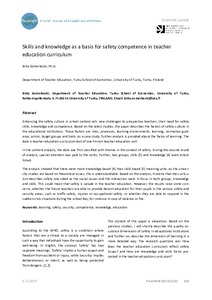Skills and knowledge as a basis for safety competence in teacher education curriculum
Brita Marianne Somerkoski
https://urn.fi/URN:NBN:fi-fe2021042827162
Tiivistelmä
Enhancing the safety culture in school context sets new challenges to
prospective teachers, their need for safety skills, knowledge and
competence. Based on the latest studies, the paper describes the factors
of safety culture in the educational institutions. These factors are
risks, processes, learning environments, learning, normative guidance,
actors, target groups and tools. As a case study, further analysis is
provided about the factor of learning. The data is teacher education
curriculum text of one Finnish teacher education unit.
In the content analysis, the data was first classified with themes in
the context of safety. During the second round of analysis, special
attention was paid to the verbs. Further, two groups, skills (S) and
knowledge (K) were established.
The analysis showed that there were more knowledge based (K) than
skills based (S) meaning units. As the university studies are based on
theoretical issues, this is understandable. Based on the analysis, it
seems that the curriculum describes safety one-sided as the social
issues and the interaction were in focus in both groups, knowledge and
skills. This could mean that safety is valued in the teacher education.
However, the results raise some concerns, whether the future teachers
are able to provide decent education for their pupils in the various
safety and security areas, such as traffic safety, injuries or
occupational safety, or whether they are able to respond in the sudden
crisis situations during the school day, for instance in case of
violence or fire.
Kokoelmat
- Rinnakkaistallenteet [27094]
